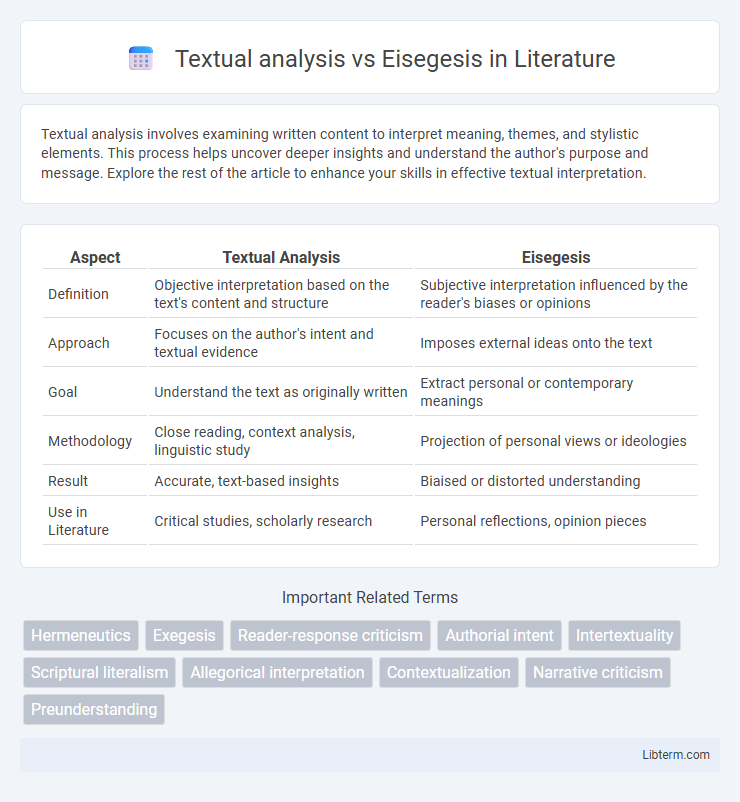Textual analysis involves examining written content to interpret meaning, themes, and stylistic elements. This process helps uncover deeper insights and understand the author's purpose and message. Explore the rest of the article to enhance your skills in effective textual interpretation.
Table of Comparison
| Aspect | Textual Analysis | Eisegesis |
|---|---|---|
| Definition | Objective interpretation based on the text's content and structure | Subjective interpretation influenced by the reader's biases or opinions |
| Approach | Focuses on the author's intent and textual evidence | Imposes external ideas onto the text |
| Goal | Understand the text as originally written | Extract personal or contemporary meanings |
| Methodology | Close reading, context analysis, linguistic study | Projection of personal views or ideologies |
| Result | Accurate, text-based insights | Biaised or distorted understanding |
| Use in Literature | Critical studies, scholarly research | Personal reflections, opinion pieces |
Introduction to Textual Analysis and Eisegesis
Textual analysis involves an objective examination of a text's content, structure, and meaning based on evidence within the text itself, aiming to understand the author's intended message. Eisegesis, in contrast, occurs when readers interpret a text by injecting their own biases, assumptions, or preconceived ideas, often distorting the original meaning. An introduction to these approaches highlights textual analysis as a critical, evidence-based method, whereas eisegesis tends to reflect subjective and interpretative readings.
Defining Textual Analysis: Methods and Goals
Textual analysis involves systematically examining the language, structure, and meaning within a text to uncover its core messages, themes, and cultural context. Methods include content analysis, discourse analysis, and thematic coding, all aimed at objectively interpreting the explicit content without inserting personal biases. The primary goal of textual analysis is to derive insights grounded in the text itself, contrasting sharply with eisegesis, which imposes external interpretations or meanings onto the text.
Understanding Eisegesis: What It Entails
Eisegesis involves interpreting a text by injecting one's own biases or preconceptions rather than deriving meaning directly from the text itself, contrasting with textual analysis which seeks objective understanding through careful examination. This method can lead to subjective readings that reflect the interpreter's beliefs rather than the original intent of the author or context of the writing. Understanding eisegesis highlights the importance of recognizing personal influence to avoid distorting the meaning of literary, religious, or historical texts.
Key Differences Between Textual Analysis and Eisegesis
Textual analysis involves examining the content, structure, and context of a text to interpret its intended meaning objectively, relying on linguistic and historical evidence. Eisegesis, by contrast, refers to reading personal biases or preconceived notions into the text, often distorting the original message. The key difference lies in textual analysis seeking to extract meaning from the text itself, while eisegesis imposes external interpretations unrelated to the author's intent.
Historical Contexts: Origins and Development
Textual analysis involves examining a document's language, structure, and meaning within its original historical context to uncover the author's intent and cultural background. Eisegesis, in contrast, imposes the reader's own biases or contemporary viewpoints onto the text, often ignoring the historical setting and authorial purpose. The development of textual analysis has roots in classical hermeneutics and modern critical methods, emphasizing objectivity, whereas eisegesis reflects a subjective interpretation prevalent in less rigorous historical study.
The Role of Objectivity in Interpretation
Textual analysis emphasizes objectivity by examining the original text's language, historical context, and authorial intent to uncover its inherent meaning. Eisegesis introduces subjective bias by imposing the interpreter's personal views or emotions onto the text, distorting its intended message. Maintaining objectivity in interpretation ensures accurate understanding and preserves the integrity of the original content.
Risks and Benefits of Eisegesis in Scholarship
Eisegesis involves interpreting texts by projecting personal biases or preconceived notions, which risks distorting the original meaning and compromising academic integrity. However, when used cautiously, eisegesis can inspire creative insights or highlight contemporary relevance, fostering dynamic scholarly dialogue. Balancing eisegesis with rigorous textual analysis minimizes interpretive errors while enriching understanding in research contexts.
Case Studies: Practical Applications and Outcomes
Case studies in textual analysis demonstrate its effectiveness in objectively interpreting texts by focusing on context, language, and author intent, resulting in consistent and verifiable outcomes across disciplines. Eisegesis, often revealed in case studies, shows how subjective interpretation can lead to biased or conflicting conclusions due to the imposition of external meanings onto the text. Practical applications highlight textual analysis as a critical tool in legal, literary, and theological fields, ensuring reliable understanding and reducing misinterpretation risks.
Textual Analysis in Contemporary Studies
Textual analysis in contemporary studies emphasizes systematic examination of texts to uncover inherent meanings based on linguistic, cultural, and contextual factors, avoiding subjective interpretation. It leverages methodologies such as discourse analysis, content analysis, and semiotics to ensure objective decoding of textual elements, enhancing accuracy in scholarly research. By contrasting with eisegesis, which imposes external biases, textual analysis offers critical insights rooted directly in the text's structure and semantics.
Choosing the Right Approach: Impacts on Meaning
Textual analysis emphasizes objective examination of the original text to uncover its inherent meaning, preserving authorial intent and context. Eisegesis involves interpreting the text through personal biases or preconceived notions, often leading to subjective or distorted meanings. Choosing textual analysis over eisegesis ensures more accurate understanding and reliable interpretation in literary and scriptural studies.
Textual analysis Infographic

 libterm.com
libterm.com